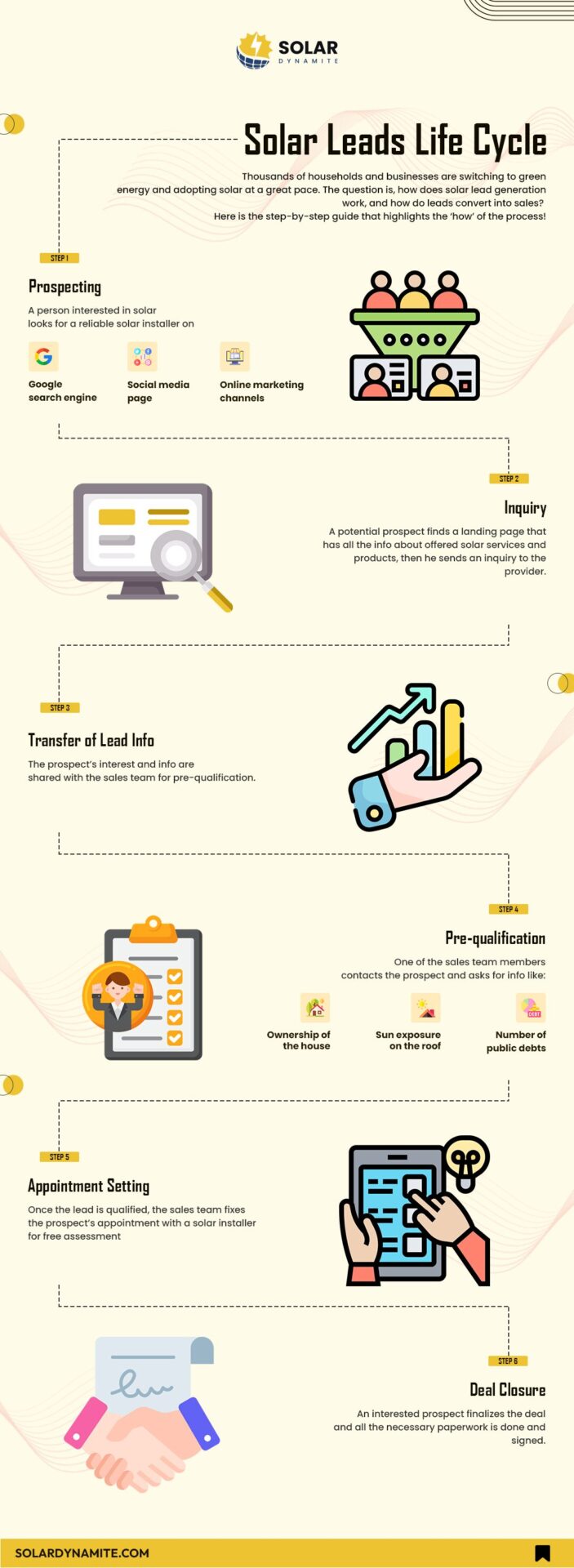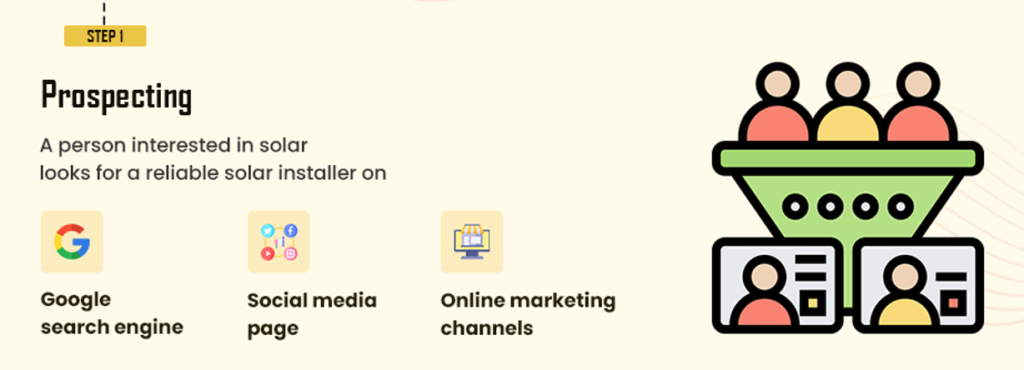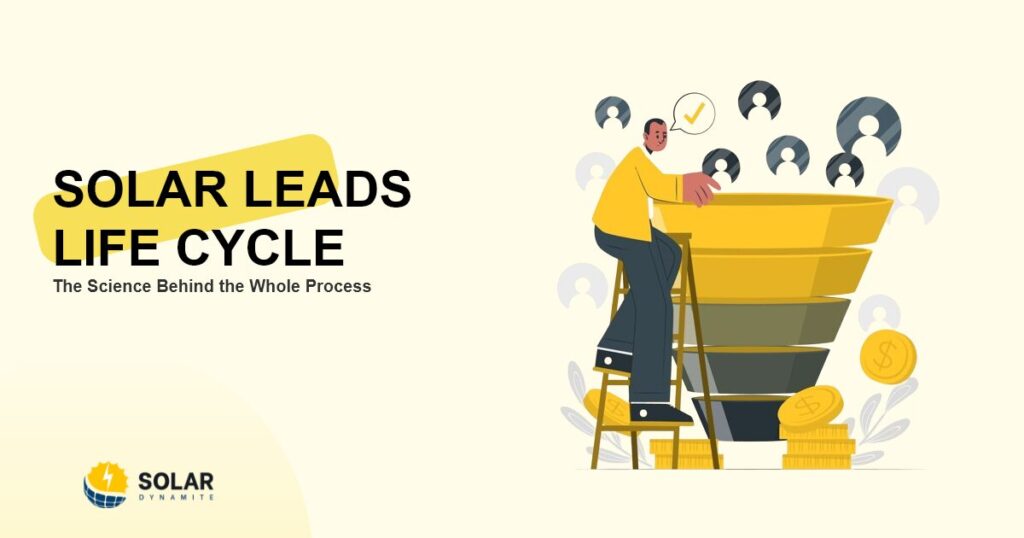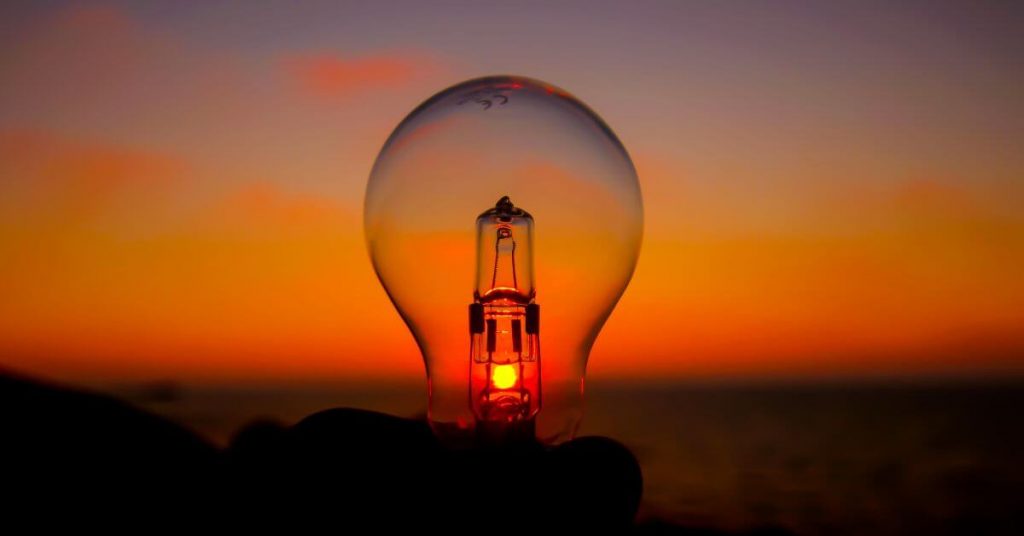While it is a no-brainer that solar lead providers produce leads in bulk, it is vital to understand how the whole solar lead generation process works for them. In this post, we will navigate you through the entire solar leads life cycle that will help you close more sales efficiently.
Sounds interesting? Let’s dive in!
Key Takeaways
- Solar leads lifecycle is a process where prospective customers are passed through a sales funnel.
- Understanding the solar lead’s life cycle and the stages involved is crucial for solar businesses.
- Lead generation companies help businesses become more efficient and earn customers by delivering pre-qualified solar leads. Many businesses outsource the lead generation task to gain more customers and drive success rapidly.
- There are several benefits of having an organized solar lead life cycle in place.
- Working through different solar leads life cycles helps businesses drive revenue growth via increased conversion.
- No matter how big or small your solar business is, you need to delegate each stage to the right team (marketing and sales) to avoid losing any prospects.
Solar lead generation demands strategic planning and unceasing efforts. However, constant hard work and even superbly crafted marketing strategies don’t transform into results and often lead to a dead end. This is why, most businesses delegate this challenging task to a reliable lead generation company to quickly convert prospective clients into loyal customers.
Understanding solar lead’s life cycle can completely change your conversion game.
That is why, we have come up with this post. It is time to understand why it is important to have an organized solar leads life cycle in place, different solar life cycle stages, and many more factors that need to be kept in check to rope in more clients.
Let’s get started!
Table of Contents
What is Solar Leads Life Cycle? Why Understanding Different Stages of Leads Life Cycle Is Important?
Solar Leads Life Cycle is the different stages that a prospect goes through a sales funnel before finally partnering with a solar installer. Efficient management of solar leads’ life cycle is crucial to streamlining the workflow of marketing and sales processes to drive more revenue.
So, why do solar companies need to understand solar leads life cycle?
Understanding the different stages of solar leads life cycle is an important step in your sales cycle. This helps you to keep your sales and marketing team on a similar page which helps your solar business to hit your conversion targets efficiently.
Here are some of the benefits of being aware of solar leads life cycle:
- It helps you craft highly targeted content that engages your target audience by teaching them about green energy, long-term savings, increased property value, etc.
- You can avoid losing SQLs (sales qualified leads) and MQLs (marketing qualified leads) with efficient marketing and sales efforts.
- Identifying which stage is offering results and which needs improvement will be easier.
- You can create accurate reports on your conversion rate on different solar leads’ life cycle stages.
Solar Leads Life Cycle: Decoding the Steps that a Lead Goes Through a Sales Funnel

Demand for solar is ascending because many households and businesses are switching to green energy due to its immense benefits. However, finding these highly qualified prospects is way more challenging than one can imagine.
This is why, many businesses partner with lead generation companies who are experts in capturing and converting potential customers into loyal ones.
So, How do lead generation companies reach out and nurture prospects into sales?
Understanding this process will help you gain an extra edge over your competitors and multiply your conversion rate efficiently.
Here is the step-by-step guide that will help you know the solar leads life cycle.
Step 1: Prospecting

In this stage, a person who is interested in solar panel installation looks for a reliable partner online. Prospective customers look for solar providers on different platforms like:
- Social Media Channels: As most solar panel installers promote their services on different social media platforms, many people look for a credible partner on major channels like Facebook, Twitter, Instagram, etc.
- Online Marketing Channels: Some of the major advertising platforms for most solar businesses are email marketing, paid search, and text marketing. Therefore, if a prospect has already received promotional mail from a solar installer, has come across a brand while searching for solar services, or got a text message about the low-cost solar installation, they will go back there to learn more.
- Google Search Engine: A Google search is the most common way of finding information online. A prospect who is interested in solar puts a query like ‘best solar provider near me, ‘the most trusted solar installer near me, or low-cost solar power provider’ in the Google search box to find reliable solar companies.
Step 2: Inquiry
In this step, the prospect finds a landing page of a website that showcases solar products, equipment, and services that a solar company offers. In this stage, prospective customers search for multiple solar panel installation companies and shortlist the ones that offer solar services that seem reliable to them.
Once they have the names of shortlisted solar companies, they put in an inquiry to learn more about their services. They contact the solar providers via chat, email, quote, or direct call. They gauge if they are offering solar installation within their budget, provide quality equipment, have years of expertise in the field, etc.
Step 3: Transfer of Lead Information
While prospects share their contact details with the company to learn more about its solar services, their interest is shared with the sales team. In this step, the sales team makes sure that the lead’s details are accurate. Once the information is validated, then it is transferred to the respective salesperson for pre-qualification.
Step 4: Pre-Qualification

In this step, one of the sales team members contacts the lead to gather more information such as:
Ownership of the house: Who owns the house? The answer to this question matters a lot in solar panel purchases. A person who owns the house is more likely to invest in the PV system installation because it elevates its overall value.
Sun exposure on the roof: Does the roof get sufficient sunlight? The efficiency of solar panels depends on the amount of sunlight the roof is exposed to. If the roof is shaded, investing in solar might not be a valuable deal for a prospect.
Number of public debts: Most states offer financial benefits to homeowners who opt for solar installation. The most common are federal tax benefits, property tax exemptions, net metering, etc. These public debts are designed to make solar purchases comfortable and easy for homeowners.
Step 5: Appointment Setting
Once the sales team gathers the information and shares all the data with the lead, they reach the next stage where they segregate leads and tag them as ‘accept’ or ‘decline’. Those leads who have accepted the offer are qualified leads and those who haven’t are not qualified or low quality leads.
In this step, low-quality leads are sent back to the lead archive which will be re-nurtured after a while. On the other hand, if the lead is qualified the sales team sets an appointment with a solar installation company consultant for a free assessment.
Step 6: Deal Closure
This is the last step in the solar lead life cycle when the qualified lead is approached for final paperwork and deal closure.
Common Solar Leads Life Cycle Stages
Working through each stage of the solar leads life cycle helps businesses optimize resource allocation, enhance customer experience, increase conversion rates, and drive the growth of revenue. It also helps businesses in
- Making data-driven decisions.
- Minimizing the length of the sales cycle
- Get a competitive advantage in the market.
Depending on your business model, here are the common progress of the solar leads life cycle stages that you should understand very thoroughly.
Subscriber
When we talk about lead generation, you have control over one thing i.e. engaging prospects and keep them returning to your site. However, you cannot begin measuring stages in a solar leads life cycle until some interested prospect shares their interest by providing basic information about them.
You need to understand that every follower or your blog subscriber will not be interested in solar installation. However, highly engaged subscribers who aren’t really solar leads can greatly help you find one and increase your social proof by sharing or commenting on your posts.
Lead
A prospect can only become a lead when he/she likes or follows your social activity, shares your blog or brand, and shows interest in the solar system installation. A lead is your potential customer whose details align with your basic demographic criteria.
Once you have found one, there are a lot of things that need to be done to convert this lead into a paying customer.
MQL (Marketing Qualified Lead)
Once the interest is shared, you will have a good amount of info about the lead. You begin with personalized communication with him/her and nurture them with more offers like affordable or discounted installation, free home assessments, solar panel design, etc.
A prospect becomes your marketing qualified lead when he/she takes actions such as:
- Watching a video where you are installing solar panels on the roof.
- Taking a quiz on solar.
- Attending a webinar.
- Downloading case studies or guides, etc.
This helps your company to understand whether a lead is worth extra effort, time, and resources to move forward into the sales funnel or not. Once a prospect becomes MQL, they are transferred to the sales team for further analysis.
SQL (Sales Qualified Lead)
Once the MQL analysis is done and qualified, they become SQL. The information of sales qualified leads is shared with the sales team for further action. They reach out to the SQLs directly and pursue them until the solar deal is closed, lost, or won.
If the sales team feels that some MQLs are not ready to move forward, they can transfer them back. Here, marketing will keep nurturing them to improve engagement until they become SQL. This stage involves a lot of back and forth.
Hot Lead
In this stage, if the sales effort and their outreach give the desired result, SQLs become hot leads. Here, the sales team will keep communicating with the lead as they are ready to invest in solar leads.
In this stage, the sales team will resolve their objections and share all the details they want to know about the solar system and its installation. The sales team needs to ensure that their response delights the hot leads to convert them into paying customers.
Customer
Hot leads will not be called a customer until it becomes one. Even after the sale, solar leads’ life cycle stages don’t end. In this stage, customer support, troubleshooting, and onboarding are crucial. You need to ensure they get what they were promised and experience the value of investing in solar installation.
Word of Mouth
A satisfied customer shares their experience with you through positive testimonials which becomes your social proof. Plus, they refer your services to their family and friends who are interested in solar installation, generating word-of-mouth or referral marketing.
Sales or Marketing: Which Department is Responsible for each Solar Leads Life Cycle Stage
Once you have determined each solar lead’s life cycle stage, you need to decide which team is handling what.
Commonly, the marketing team is responsible for MQLs, subscribers, and leads whereas sales manage SQLs and hot leads. No matter how big or small your solar business is, you need to delegate each stage to the right team to avoid losing any prospects.
One of the best ways to ensure alignment between marketing and sales is to build an SLA (service level agreement) between these two teams.
So, What is an SLA?
SLA or service level agreement is a type of bond where both the marketing and sales teams agree to deliver a particular number of leads. For sales, the entire team promises to follow up with SQLs and hot leads within a specific timeframe. For marketing, they agree to convert a certain number of prospects into leads.
Here is an example of SLA between the marketing and sales teams:
The marketing team will deliver 1500 qualified leads to the sales team each month. Then, sales will pursue these 1500 qualified leads within a day after receiving their info.
The Closure on Solar Leads Life Cycle
By now, you must have understood what solar leads life cycle is and how having different stages organized in the right place is crucial for your business success.
Start engaging your followers with compelling content and showcase what makes you the best solar installer in your state. Aim to convert a subscriber into an SQL. Delegate the right set of responsibilities to your sales and marketing teams to avoid any slip-ups.
So, this was our detailed blog on solar leads life cycle. We hope you have found this post helpful!




